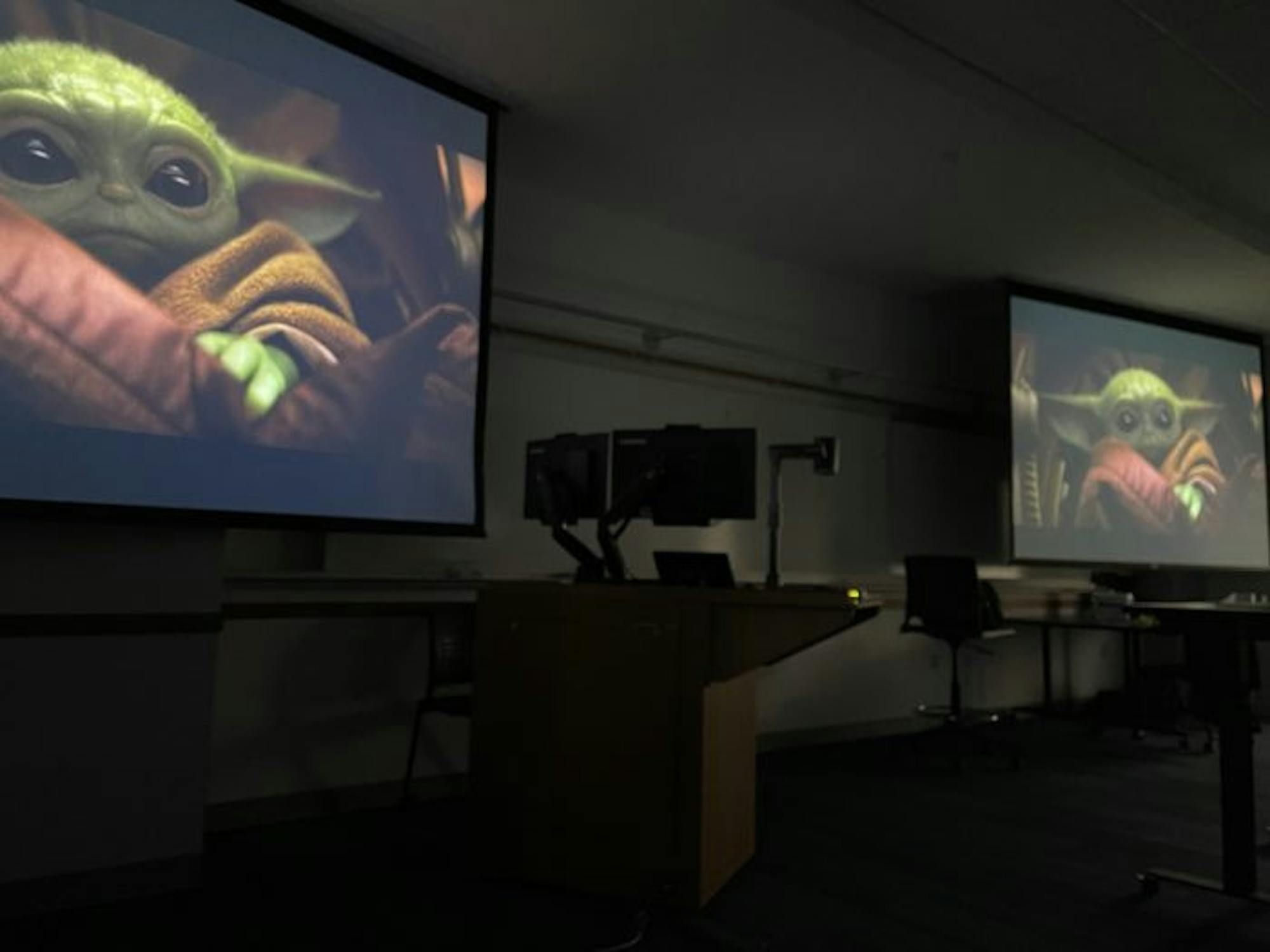Students stepped out of the rain Wednesday evening as they walked into Corbett Family Hall.
They sat down for a discussion on the consequences of sin and the cycle of life, as well as heroes, myths and creeds. The particulars of the conversation were all grounded in episodes of the Disney+ “space Western” series “The Mandalorian.” The discussion was interspersed with dramatic clips of the show projected onto the screen.
The series, which takes place in the “Star Wars” universe and initially premiered late 2019, is the subject of a one-credit course called “Unmasking The Way: Theology of and For The Mandalorian.” The show focuses on a titular bounty hunter, always masked in a suit of armor, and his pursuit to protect a child thatfans dubbed “Baby Yoda.”
Fr. Kevin Sandberg, CSC, an assistant teaching professor in the Center for University Advising and a priest-in-residence in St. Edward’s Hall, teaches the class.
Sandberg said the inspiration for the course came during the pandemic.
“Everyone was wearing a mask, and there were hidden things about people that you wanted to know and you wanted to disclose. And the mask struck me as a barrier to that as much as it was a barrier to disease,” Sandberg said. “At the same time, I started to see ‘The Mandalorian’ and I, like a lot of people, fell in love with Baby Yoda as we called him then and recognize that there was this immediate connection between this innocent child, and this man who, for his complete adult life had been masked.”
Luke Blazek, a sophomore in Pangborn Hall, said he identifies as a “huge ‘Star Wars' fan.” Blazek said he took the class because, having watched the series more than once before the class, he had felt there was something more to the show.
“The level of intricacy involved in the show; there's so much more than your base level T.V. show and so I always kind of had an inkling that there's so much more to ‘The Mandalorian,’” Blazek said. “When I came across a class like this, it seemed as though it formulaically dissected the hidden pieces to the show and then brought them to light… there were a lot of theological themes.”
Along with watching the first two seasons of “The Mandalorian,” and its spin-off series “The Book of Boba Fett,” students in the class are reading C.S. Lewis’ “Till We Have Faces,” a retelling of the ancient myth of Cupid and Psyche. Later, they will read “Revelation” by Flannery O’Connor, which is a short story that poses questions about salvation and divine grace.
Kameron Hussey, a sophomore in Welsh Family Hall, said she’s always had an interest in how theology connects to the wider world, but unlike Blazke, Hussey said she had never seen the series prior to enrolling in this class.
“I've never attributed ‘Star Wars’ to anything religious, and so I thought [the class] would be a good opportunity to find connections within a new form of culture that I'm not overly familiar with, but I think provides a lot of good information,” Hussey said.
Although “The Mandalorian” may seem a strange avenue for theological conversations, many have identified and applauded explicit religious themes in the series. Sandberg said he felt the same way, drawing parallels to key concepts in Christian religion.
“What struck me as theological from the very beginning was that an innocent child was to be massacred and otherwise was saved and taken from the clutches of evil, i.e. the story of the nativity of Jesus,” Sandberg said. He also identified a battle between good and evil in the series.
“You can see it in ‘Harry Potter.’ [Good and evil] becomes the terrain on which the battle between Albus Dumbledore and Voldemort is executed. And so similarly with Baby Yoda, he becomes a vehicle for evil to reassert itself,” Sandberg added. “The potential for good that's in the Mandalorian for instance, has to be activated to prevent that evil from happening.”
Those themes are even more explicit in the names of theseries’ episodes, Sandberg said.
“If you look at the episode titles of ‘The Mandalorian,’ they’re replete with religious imagery: the child, the sin, sanctuary, redemption,” he said.
Over the course’s ten meetings, students will be preparing for a storyboard project, in which they’ll present their storyboards for the next episode of The Mandalorian.
Sandberg hopes that the class can go beyond an academic pursuit for the correct answer.
“Many students want to have the right answer. But this isn't about the right answer. It's ultimately about ‘what am I going to do with my life in such a clash of forces like good and evil?’” he said.
Sandberg said the University teaches students to be a force for good, in line withFr. Edward Sorin’s famous letter but can fall short in teaching that lesson.
“Nobody defines the good and I think it's incumbent upon faculty in particular, but also from a religious perspective to point out that, where we end up fighting for good is when it clashes up against evil, and we forget how much evil there is in the world until we run up across [events like the Russian invasion of Ukraine],” Sandberg said. “And certainly, isn't that something that's written large in the ‘Star Wars’ narrative?”
Theology course looks to ‘Star Wars’ series for answers to life’s big questions
An clip of "The Mandalorian" featuring 'Baby Yoda' projected onto screens in Corbett Family Hall Wednesday night for a meeting of a one-credit course called “Unmasking The Way: Theology of and For The Mandalorian.”
An clip of "The Mandalorian" featuring 'Baby Yoda' projected onto screens in Corbett Family Hall Wednesday night for a meeting of a one-credit course called “Unmasking The Way: Theology of and For The Mandalorian.”









